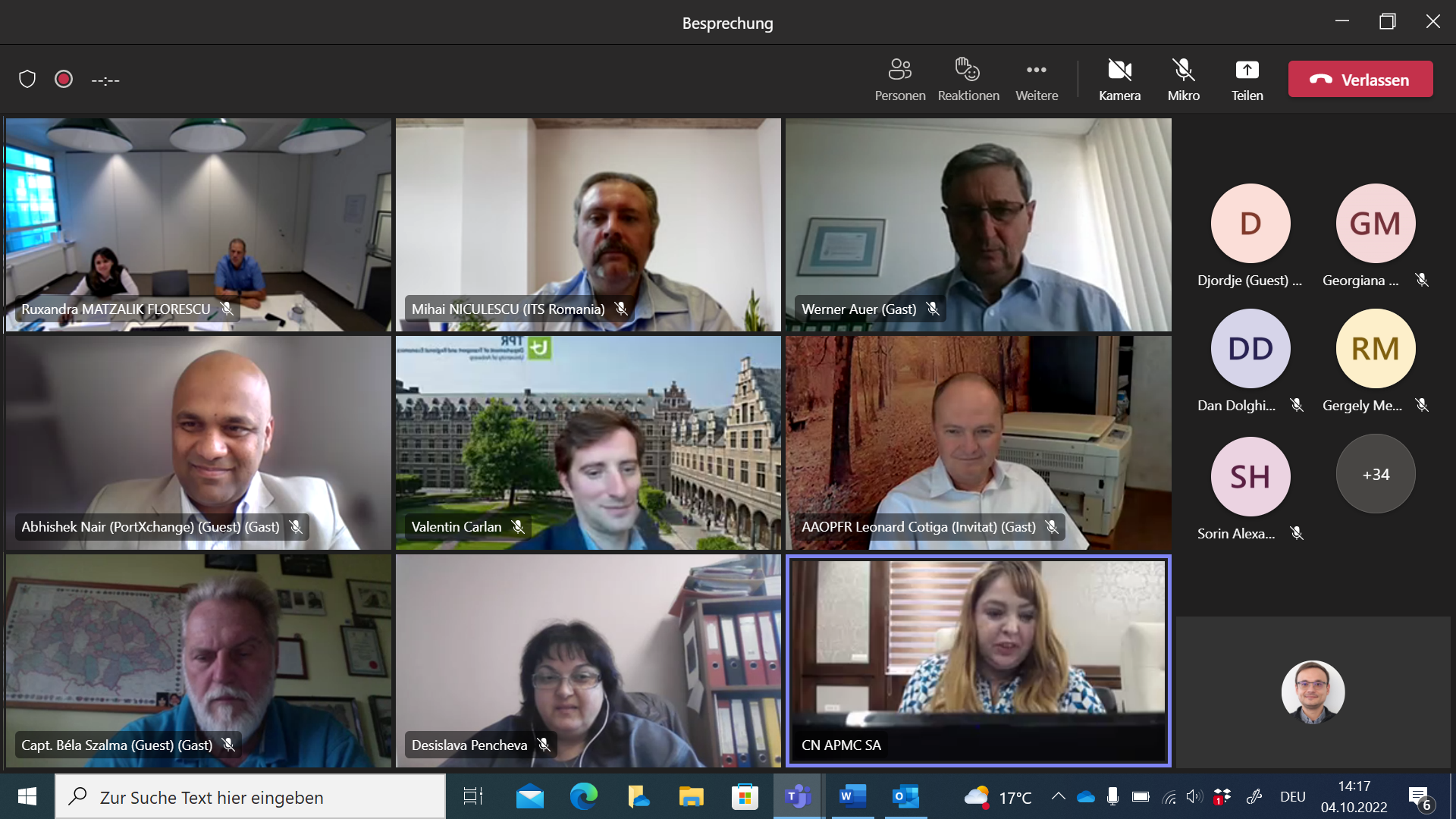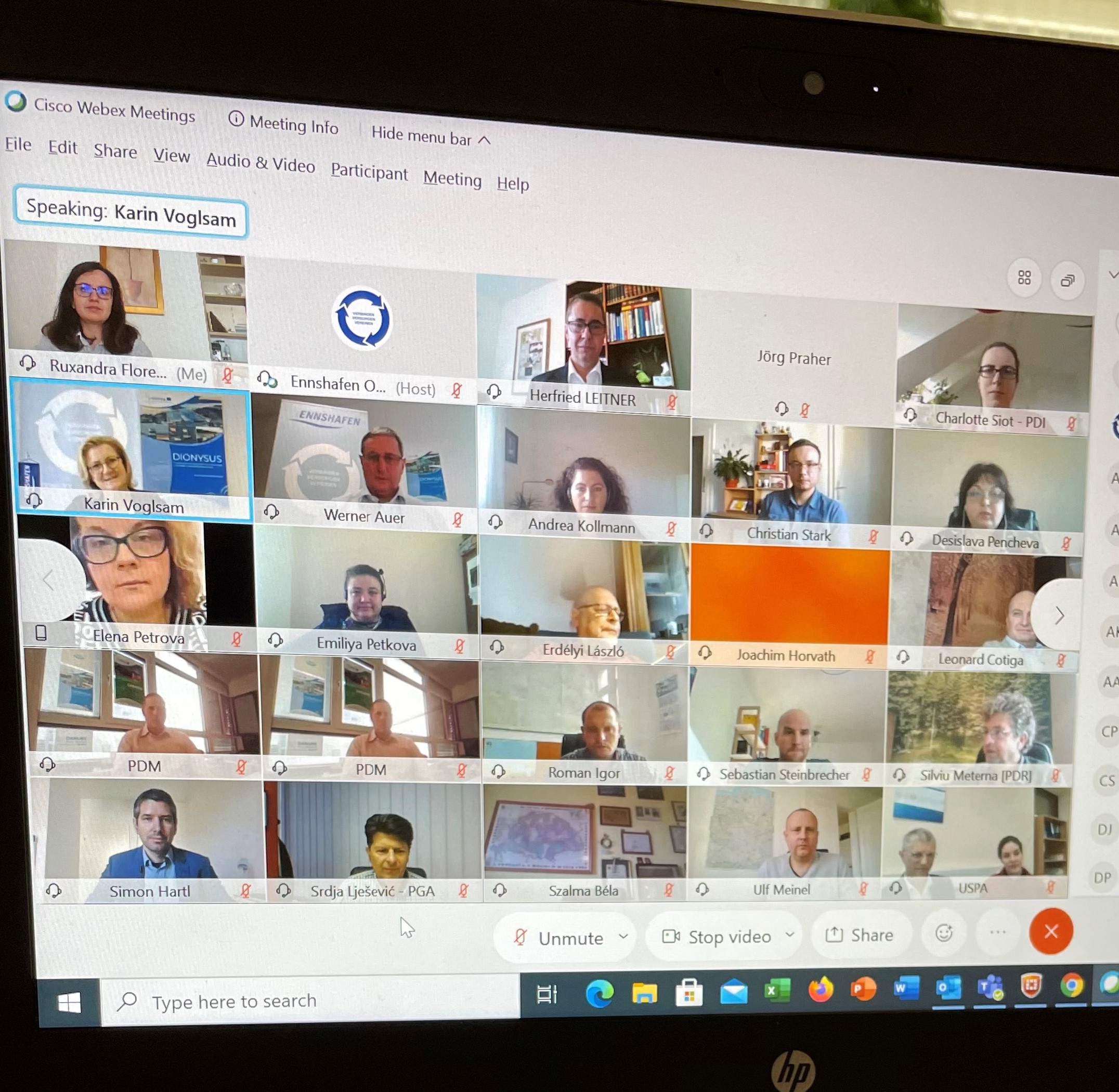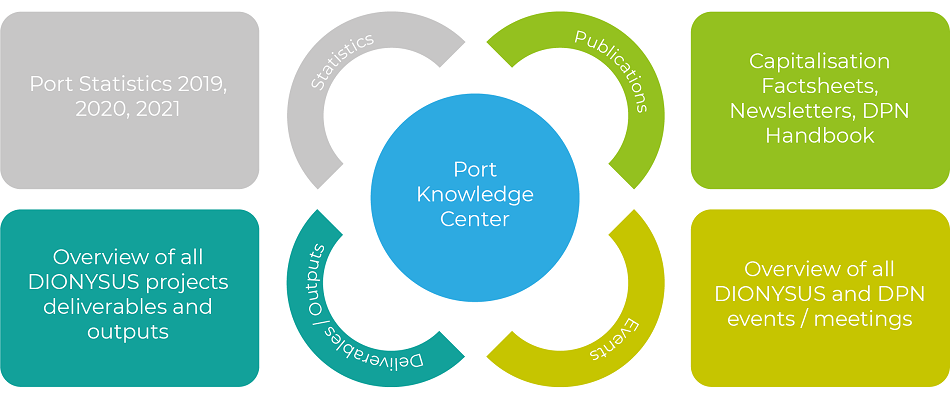The event brought together more than 70 experts from the Danube Region and beyond, interested in topics related to (i) the potential of inland ports in urban mobility, (ii) fleet electrification as well as (iii) sustainable port logistics solutions. General information on the DIONYSUS project was presented by Mr Silviu Meterna of Pro Danube Romania, the lead partner of the DIONYSUS project. The audience received detailed information on funding opportunities, such as the new Interreg Danube Transnational Programme as well as on Connecting Europe Facility 2.
Good practice examples in the field of Danube vessel fleet electrification, as well as sustainable logistics and port solutions in urban areas, were presented by highly experienced stakeholders. Mr. Tomislav Uroda representing iCAT, a Croatian company specialised in innovative ship design and shipbuilding gave an insight into their solar-powered passenger vessel concept. Mr. Edwin van Hassel from the University of Antwerp introduced the “Smart Waterway Project”, a concept developed in order to demonstrate the benefits of using waterways for the distribution of freight in the urban area of Ghent. Mr. Robert Rafael on behalf of the DPN introduced notable examples of sustainable practices collected from several logistics service providers operating in the urban area of Budapest. Moving further downstream towards the Port of Constanta, Mr. Alexandru Craciun representing DP World Constanta shared very interesting insights on DP world’s innovative initiatives to be rolled out in the Danube Region.
We would like to use this opportunity to give special thanks to all our speakers, including Ms. Katharina Lenz of EU Danube Strategy Point, Mr. Horst Schindler of DTP Joint Secretariat, Mr. Turi Fiorito of EFIP, Mr. Danijel Bilušković of Port of Vukovar Ltd and to the moderators Ms. Iva Horvat, Ms. Ruxandra Matzalik Florescu and Mr. Miroslav Madarac.
List of presentations:
01_2021_11_23_PDR_Silviu Meterna
02_2021_11_23_EU Strategy Point_Katharina Lenz
04_2021_11_23_JS_Horst Schindler
05_2021_11_23_EFIP_Turi Fiorito
06_2021_11_23_Port of Vukovar_Danijel Biluskovic
07_2021_11_23_iCat_Tomislav Uroda_Electric Vessels
08_2021_11_23_University of Antwerp_Edwin van Hassel
10_2021_11_23_DP World_Alexandru Craciun
IWT Digitalisation Workshop successfully organised
On 23 November, more than 100 stakeholders from the public and the private sector participated in the transnational workshop on digitalization in Inland Waterway Transportation (IWT). The workshop was a joint initiative of the European projects Platina 3, Masterplan DIWA, RIS COMEX and DIONYSUS and the sector organizations Pro Danube Management, EICB and the IWT Platform with the support of the DPN.
The workshop focused on how digital transformation can support business activities and reporting formalities in the upcoming years. Participants provided valuable inputs regarding further requirements on synchromodality, ICT infrastructure, River Information Services and Smart Shipping, data sharing & integration, cybersecurity and compliance.
During the plenary part of the workshop, the 4 projects were introduced by short interviews moderated by the Master of Ceremony Henk van Laar. The workshop perfectly fitted into the timelines of each project, as currently project partners of PLATINA3, Dionysus and the masterplan DIWA are working on collecting input for their dedicated studies, yet at the same time giving them the chance to share intermediate results with a wide range of experts. The RIS COMEX project will launch its European fairway information portal ‘EuRIS’ in the course of 2022.
Four themes
After the break, the participants joined either one of the four break-out rooms to go into more detail and moreover to share opportunities, requirements and discuss how relevant authorities together with the industry representatives can support a successful digital transformation in IWT.
The themes of the four break out rooms were:
- Smart Shipping
- Synchro modality
- River Information Services
- Sea and inland ports
This thematic approach resulted in lively discussions and new expert inputs relevant for all of the European projects. During the final plenary part, the results of the discussions in the break-out rooms were shared with all the participants. Representatives from European Commission’s DG MOVE congratulated the initiative and highlighted the need for similar future cooperation activities of the IWT sector in Europe.
Workshop on Ports & Agricultural Products Traffic in the Lower Danube Region Countries
The event brought together Lower Danube Region’s port administrations, port operators and service providers (storage operators), agricultural producers and traders as well as logistics service providers to discuss on the present and future traffic flows in the Danube Region. The workshop analyzed the existing transport infrastructure together with the status-quo of the on-going and planned infrastructure projects, as basis for the elaboration of various assumptions on potential traffic and trade agricultural flows of the Danube ports. The workshop was organised on 17 November 2021 by AAOPFR.
Second Workshop on Container Liner Services
Organised on 7 December online by FTTE, the core objective of the second edition of the workshop was to bring together experts to discuss about the revival and further development of Container Liner Services on the Danube River. Attended by representatives of the EC, the DC, national authorities and stakeholders operating on the Danube, the event provided the interested audience both with first-hand information on the advantages of container liner shipping as well as on the challenges that hamper its development. The event was a follow-up of the successful event organised in December 2020 by the Port of Constanta.
First Workshop to facilitate cross-border/cross Black Sea services
The aim of the First Workshop to facilitate cross-border/cross Black Sea services (08.12.) aimed to identify the possibilities and opportunities to build up new transport links among the Danube corridors and the riparian Black Sea & Central Asia regions.
The workshop analysed the existing transport infrastructure together with the status-quo of the on-going and planned infrastructure projects, as basis for the elaboration of various assumptions on potential traffic and trade flows of the Danube ports in connection to the development of the transport links to the corresponding corridors, collecting important and valuable feedback for the design and operation of potential new cross-border/cross-Black Sea transport links.
Workshop on Ports & Agricultural products Traffic in the Middle Danube Region Countries
The event targeted Middle Danube Region’s port administrations, port operators and service providers (storage operators), agricultural producers and traders as well as logistics service providers. It discussed present and future traffic flows and the throughputs of agricultural products in the ports located in the sub-region Middle Danube (HU, HR, RS).
Danube Ports Day 2022
Continuing the well-established practice initiated by the DAPhNE project, the 2022 edition of the Danube Ports Day event was successfully organised in the frame of the DIONYSUS project by Pro Danube Management (PDM) and the Maritime Ports Administration Constanta (MPAC) with the support of the Danube Ports Network (DPN). By bringing together numerous experts from the Danube Region and beyond, the event set the scene to discuss hot topics related to i) the Ukrainian goods exported from Danube ports and the new logistics chains, ii) transport of goods on the Lower Danube – reflecting on infrastructure conditions, opportunities, and challenges, iii) digitalization trends and intermodal logistics in the Danube Region.

Keynote interventions were delivered by Mrs. Isabelle Ryckbost, Secretary General of the European Sea Ports Organisation (ESPO) and Mr. Alain Baron, Adviser to the Rhine-Danube Corridor Coordinator. Both interventions highlighted that despite the challenges caused both by the conflict in Ukraine as well as by the immediate consequences of climate change – ports must maintain their forefront role in the international distribution of goods.
Two interactive sessions – on intermodality and logistic chains moderated by the Danube Commission as well as on digitalisation in the Danube Region moderated by Pro Danube Management – brought together experts and stakeholders to discuss these vital aspects of Danube transportation. While the first session aimed at identifying adequate solutions to the most common hurdles that still need to be overcome – both in terms of proper fairway maintenance as well as considering the difficulties caused by the conflict in Ukraine, the second session, on digitalisation, discussed the future of IWT in the digital age, providing concrete examples of good practices from Western, Central and Eastern Europe. It was concluded that proper navigability conditions need to be adequately ensured and maintained continuously in order to enable the functioning of reliable logistic services, whereas digitalisation is an indispensable prerequisite for the implementation of the ambitious climate goals enshrined in the European Green Deal.
We would like to use this opportunity to thank our speakers for sharing insights into their various fields of activities.
The presentations are available for download here:
Interactive session on intermodality & logistics chains
Mr. Djordje Krkljus_COMVEX_Keeping Ukrainian goods moving - Danube and the new logistic chains
Session on digitalisation in the Danube Region
Mr. Werner Auer_Ennshafen Port_Danube Port Digitization - Strategy & Action Plan
Mr. Gergely Mező_RSOE_Integrated Port Information System in Hungary - KIR
Capt. Abhishek Nair_PortXchange_Port digitalisation in Rotterdam and connected ports
Dr. Valentin Cârlan_University of Antwerp_Synchro-modal logistics supported by digitalisation
Ports and agricultural ports traffic in the Upper Danube Region countries
As part of A.T 3.2, the Regional Workshop dedicated to Ports and Agricultural Products Traffic was organised by PP14 Wieser Consult. The workshop discussed present and future traffic flows, the throughputs of agricultural products in the ports located in the sub-region Upper Danube (AT, DE, SK). The workshop analysed the existing transport infrastructure together with the status-quo of the on-going and planned infrastructure projects, as basis for the elaboration of various assumptions on potential traffic and trade agricultural flows of the Danube ports Infrastructure and superstructure needed in the ports, as well as connecting road and rail infrastructure, were identified and mapped.
Third workshop on Container Liner Services
Organised in the framework of the DIONYSUS project by the Port of Constanta, the third workshop on Container Liner Services successfully brought together more than 50 participants involved in the promotion and development of containerized transport on the Danube ranging from decision-makers, representatives of the Danube Transnational Program, of EFIP and viadonau to members of the project consortium, academia as well as business representatives operating on the Danube and beyond.
The third and final event in this series offered the stage for interested stakeholders to discuss the potential and future of container transport on the Danube. The event set the scene to reflect and evaluate aspects related to lessons learned and new market conditions, and the prospects for relaunching and supporting this type of transport.
Second stakeholder's meeting on port pricing systems
Organised in the frame of DIONYSUS, the 2nd Stakeholders’ Meeting on Port Pricing Systems was successfully organised on 14 June by the Port Authority Vukovar. The event brought together experts from the Danube Region to discuss applied port pricing principles and methodologies in Austria, Croatia, Hungary, Serbia and Romania.





